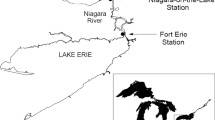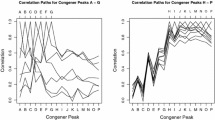Abstract
When investigating trace substances in ambient water, a proportion of water sample concentrations is usually below limits of detection. In medical and industrial reliability studies, comparisons are often made of time to event data which includes right censored observations indicating only that an observation is greater than a specified value. In this paper consideration is given to the application of non-parametric procedures, widely used in the analysis of time to event data, to water quality data which is left censored.
A non-parametric estimate of the cumulative distribution function for left censored water quality data can be generated quite easily. For the comparison of levels of trace substances it is necessary to combine an unconditional likelihood for the proportion of observations below a detection limit with a partial likelihood for the portion of the distribution above the detection limit in order to make use of regression methodology. The details of this are outlined and an example is given which compares levels of toxic substances at the head and mouth of the Niagara river.
When comparisons are based on matched pair data, further modifications are necessary. A development paralleling that for time to event data is given. Consideration is also given to model extensions which allow for a dependence between observations at the same location over a period of time.
The presentation is introductory and designed to illustrate the potential of some available methodology for use in the analysis of water quality data.
Similar content being viewed by others
References
Cox, D. R.: 1970, The Analysis of Binary Data, Methuen, London.
Cox, D. R.: 1972, ‘Regression Models and Life Tables’, (with discussion). J. R. Statist. Soc. B34, 187–220.
Cox, D. R.: 1975, ‘Partial Likelihood’, Biometrika 62, 269–276.
Helsel, D. R.: 1986, ‘Estimation of Distributional Parameters for Censored Water Quality Data’, in Statistical, Aspects of Water Quality Monitoring, A. H.El-Shaarawi and R. E.Kwiatkowski (eds.), Elsevier, New York.
Holt, J. D. and Prentice, R. L.: 1974, ‘Survival Analyses in Twin Studies and Matched Pair Experiments’, Biometrika 61, 17–30.
Kalbfleisch, J. D. and Prentice, R. L.: 1980, The Analysis of Failure Time Data, Wiley, New York.
Kaplan, E. L. and Meier, P.: 1958, ‘Nonparametric Estimation from Incomplete Observations’, J. Am. Stat. Assoc. 53, 457–481.
Peto, R. and Peto, J.: 1972, ‘Asymptotically Efficient Rank Invariant Procedures’, J.R. Statis. Soc. A135, 185–207.
Author information
Authors and Affiliations
Rights and permissions
About this article
Cite this article
Farewell, V.T. Some comments on analysis techniques for censored water quality data. Environ Monit Assess 13, 285–294 (1989). https://doi.org/10.1007/BF00394234
Issue Date:
DOI: https://doi.org/10.1007/BF00394234




